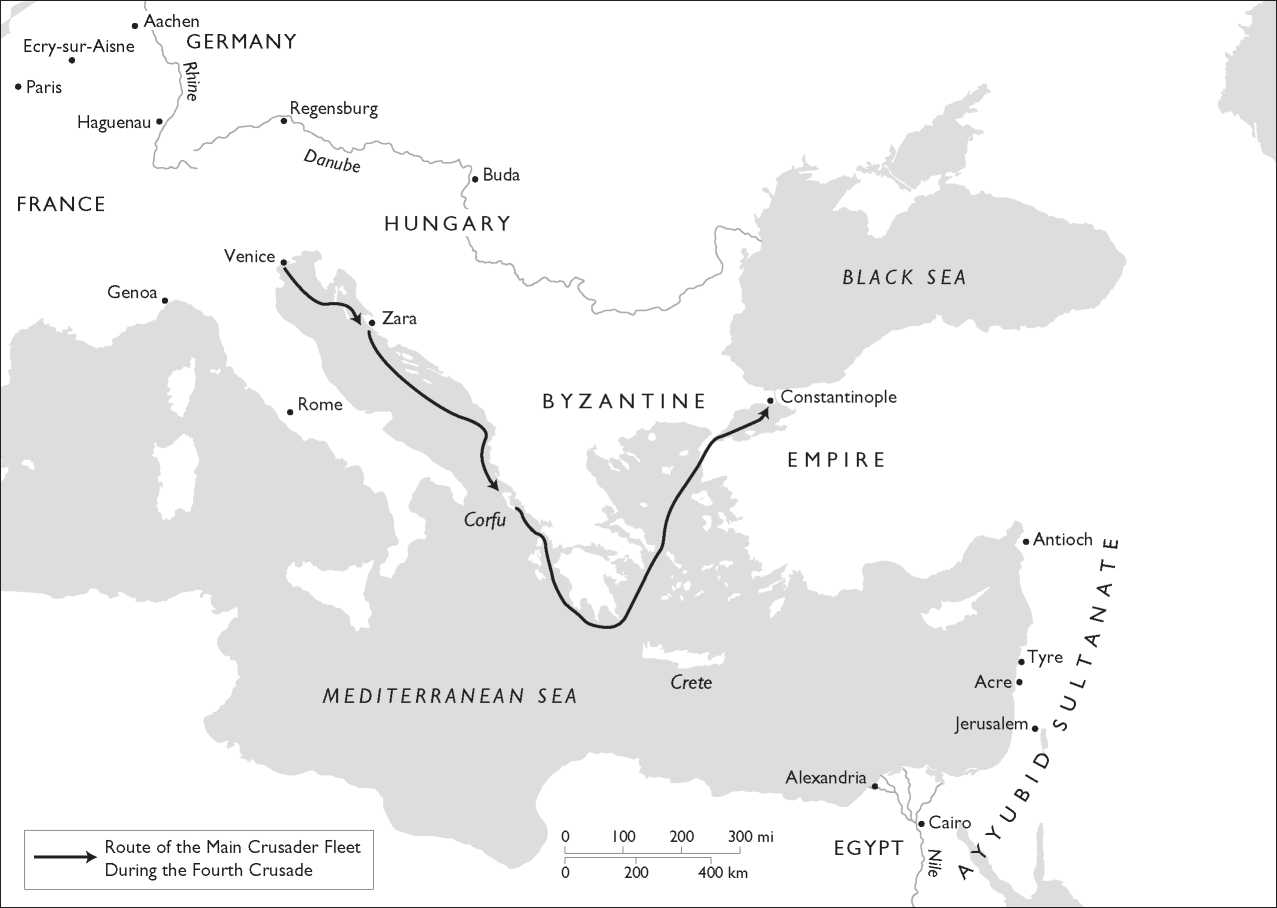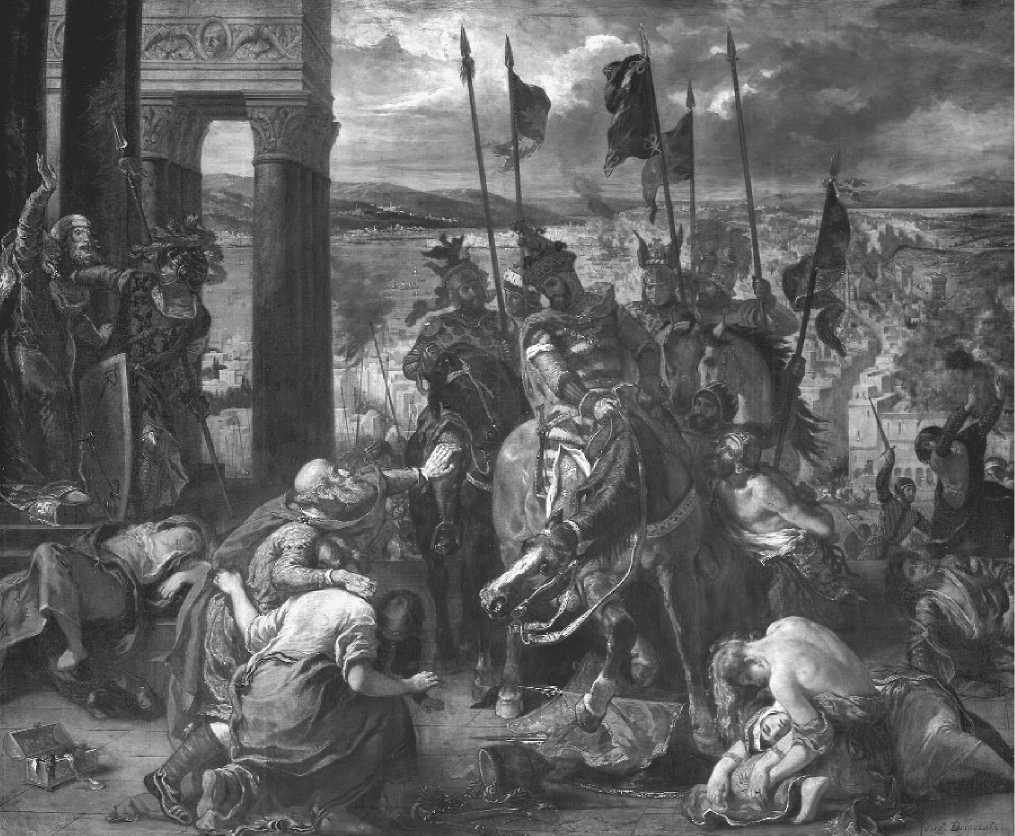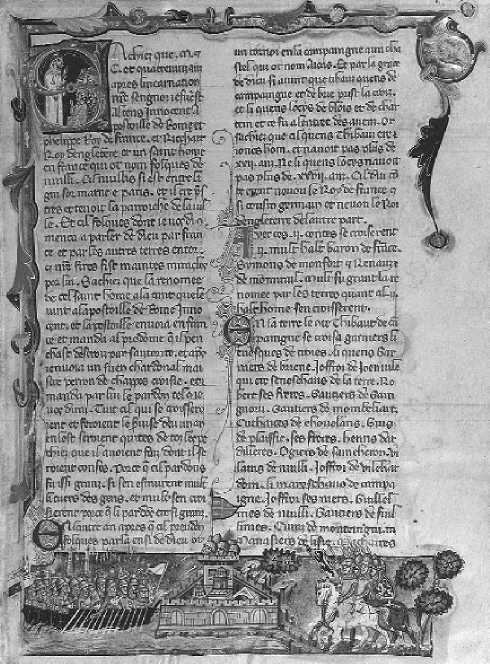A crusade launched by Pope Innocent III with the aim of liberating Jerusalem through an invasion of Ayyubid Egypt, the chief center of Muslim power in the Levant. In the event, the main body of the crusade was diverted, initially to attack the Christian city of Zara (mod. Zadar, Croatia), and then to

Route of the Main Crusader Fleet during the Fourth Crusade

The Crusaders Take Constantinople (1204), by Eugene Delacroix, Louvre, Paris. (Erich Lessing/Art Resource)
Constantinople (mod. Istanbul, Turkey), where it overthrew the Byzantine Empire and established a Latin regime in its place. Relatively few crusaders made their way to the Holy Land, but those who did were able to help the Latin kingdom of Jerusalem to stabilize and slightly extend its borders.
Origins
On 15 August 1198, Pope Innocent III published his first crusade encyclical, calling for an expedition to liberate Jerusalem that would leave in March 1199. Soldiers would serve a minimum of two years overseas, and in addition to the indulgences and other privileges accorded all crusaders, the pope offered indulgences to anyone who subsidized a crusader. He appointed two crusade legates, the cardinals Soffredo and Peter Capuano. Soffredo was sent to enlist the aid of Venice, and because Innocent blamed Christendom’s failure to recapture Jerusalem on the bickering of its rulers, he dispatched Peter to establish peace between the kings of England and France. He commissioned two other cardinal legates to negotiate an end to the war between Genoa and Pisa. The peace missions to Genoa and Pisa failed, and the five-year truce that Cardinal Peter negotiated between Richard I of England and Philip II of France died along with King Richard in March 1199.

Fulk of Neuilly preaching the Fourth Crusade. Lower border shows crusaders arriving at Constantinople. From La Conquete de Constantinople, by Geoffrey of Villehardouin, c. 1330. (The Art Archive/Bodleian Library Oxford)
Believing that spiritual reformation was another key to success, Innocent enlisted the services of the French evangelical preacher Fulk of Neuilly. On 5 November 1198, the pope granted Fulk permission to enroll monks and canons regular as assistants in preaching the cross. Fulk handed out thousands of crosses, largely to the poor. The high and mighty, who were essential if a crusade army was to take shape, were another matter.
March 1199 came and went with no discernible response from Europe’s elites. On 31 December 1199, the pope dispatched a second crusade encyclical, in which he reduced the minimum time of service to a year and set up a church-wide system for raising funds for the Holy Land. He levied a 2.5 percent income tax on all nonexempt clerics, taxed tithe-exempt orders, such as the Cistercians, at a rate of 2 percent, laid a tax of 10 percent on himself, and set up chests in churches throughout Europe for the reception of donations from the laity. In return, all donors would receive an indulgence. In this manner the pope hoped to involve all of Western Christendom in the crusade and thereby allow everyone to share in its graces. It was this second encyclical that established a new system for raising funds for crusading and other papal programs. Clerical taxes and donation chests in churches became fixtures in the Roman Church and remained so long after the crusades were over. However, the total amount raised for Innocent’s crusade was disappointing, and it became clear that most individual crusaders would have to pay their own expenses.
Recruitment and Organization
The preaching of Fulk of Neuilly, Peter Capuano, and others bore fruit when Counts Thibaud III of Champagne and Louis I of Blois took the cross at a tournament at Ecry-sur-Aisne on 28 November 1199. Other lords and knights followed suit, including Baldwin IX of Flanders, Hugh of Saint-Pol, Geoffrey III of Perche, and Simon of Montfort. The great lords dispatched six plenipotentiaries to secure sea transport and supplies; they included Geoffrey of Villehardouin, marshal of Champagne, the future historian and apologist of the crusade. In late winter 1201, the envoys concluded a treaty with the republic of Venice for the transport and provisioning of 33,500 men and 4,500 horses for a payment of 85,000 marks of silver on the standard of Cologne. A fleet of ships sufficient to carry all of these men and their animals, as well as fifty war galleys to be provided at Venice’s own expense, was to be ready to sail on 29 June 1202, along with provisions for nine months. The objective, Egypt, made strategic sense, as it was the center of Ayyubid power and potentially the first step on a triumphal march to Jerusalem, but this destination was kept secret from the rank and file. Venice became a full partner in the crusade and was to receive a half-share of spoils. The city suspended commerce and turned to full-time ship refitting and construction, drafting half its able-bodied men as sailors and marines.
The Venetians upheld their contractual obligations, but the leaders of the crusades had far less control over circumstances surrounding their half of the compact. Thibaud of Champagne died on 24 May 1201. The nominal leadership of the crusade was then offered to, and accepted by, Boniface I, marquis of Montferrat in Lombardy. Boniface duly assumed the crusader’s cross at Soissons in late summer 1201 and probably added a substantial number of followers to the crusade. They were not, however, enough to swell the army’s forces to anything approaching the number that the French envoys had estimated would sail from Venice. What is more, the contracted embarkation date of 29 June 1202 arrived and passed with crusaders still straggling into Venice. Even Boniface did not leave home until early August. Many crusaders chose not to rendezvous at Venice but sailed to Outremer from other ports. The cost of passage also dissuaded many. In the end, no more than 12,000-13,000 warriors assembled at Venice. After their money was collected and after the great lords had contributed everything they had or could borrow, the army could only raise 51,000 marks, a shortfall of 40 percent. Venice needed to recoup its investment in time, lost commerce, and materials. To make matters worse, the army’s campsite on the sands of the Lido became increasingly oppressive as the hot summer wore on, and the rate of deaths and defections rose alarmingly.
The Diversion to Zara (1202)
In the midst of this crisis, a compromise was proposed by Enrico Dandolo, doge of Venice: the republic would defer payment of the 34,000-mark balance until the army enriched itself with plunder in Egypt, if the army would assist Venice in regaining control over the rebellious city of Zara on the coast of Dalmatia. This proposal was consonant with contemporary mores, inasmuch as every lord or city had the right to secure the loyalty of subject territories before setting off on crusade. Yet it was dangerous, in that Zara, a Latin Christian city, had pledged its loyalty to King Imre of Hungary, himself a sworn crusader, which meant that his lands were under papal protection.
Faced with the choice of accepting the doge’s offer or allowing the crusade to disintegrate, the lords agreed to go to Zara. The aged and blind doge requested permission from the Venetians to take up the crusader’s cross himself, which he received on 8 September. In response to Dandolo’s display of piety, many Venetians who had escaped being drafted for the crusade fleet now flocked to the cause. Venetian draftees and the new volunteers, as well as conscripts later enrolled from Adriatic port cities under Venetian hegemony, combined to raise the number of crusaders to probably over 44,000. This meant that 70 percent or more of the crusaders who sailed with the fleet were Venetians or citizens of cities subject to Venice.
Some of the non-Venetian crusaders from northern Europe who heard of the decision to go to Zara were troubled. These included Abbot Martin of Pairis and Bishop Conrad of Halberstadt, who were commanded by the legate Peter Capuano to stay with the army and work to reduce the level of violence at Zara. However, the Venetians, fearing Peter would forbid the attack once the fleet was under way, refused to accept him as a papal legate, and he returned to Rome, where he informed the pope of this turn of events. Innocent III forbade any attack on Zara under threat of excommunication and dispatched a letter to the army to that effect. It was a canonical yet ultimately impractical response to the crusaders’ predicament.
The fleet, consisting of 50 war galleys, about 150 horse transports, and an unknown number of other transport vessels, set sail at the beginning of October 1202, reaching Zara in two divisions on 10 and 11 November. Initially the Zarans were ready to capitulate, but they were dissuaded by some dissidents within the army who believed the pope’s warning would forestall any attack. It was bad advice. Despite hearing the pope’s words forbidding any violence to the Zarans, most soldiers joined the Venetians in bombarding the city and undermining its walls. On 24 November the Zarans capitulated, and their city was sacked.
The Venetian and Frankish crusaders settled down in winter quarters in the captured city. During the winter, a number of dissident crusaders left the army, some for home and others to the Holy Land. Those who remained behind were eager to have the ban of excommunication lifted from their shoulders. They prevailed upon the clergy traveling with the army to absolve them and sent a legation to Rome to beg papal forgiveness.
Despite his anger, Innocent accepted the Frankish crusaders’ profession of contrition and plea that they had acted out of necessity. In February 1203 he provisionally lifted the ban, provided that the crusade leaders bound themselves and their heirs to make full restitution to the king of Hungary. He also ordered them to swear formally never again to attack Christians, save in the most exceptional circumstances, and then only with the approval of the pope or his legate. The Venetians, who admitted no wrongdoing, did not at first seek papal absolution and remained excommunicated. Although Christians normally had to shun excommunicated persons, this extraordinary situation called for extraordinary measures, and Innocent allowed the army to continue to sail with the Venetians.
The Treaty of Zara (1203) and the Diversion to Constantinople
In Zara the crusaders’ provisions were dwindling, and their funds were exhausted. While their legates were on their way to Rome, they received emissaries from Philip of Swabia, claimant to the throne of Germany, begging the army to help his brother-in-law, Alexios Angelos. Alexios’s father, the Byzantine emperor Isaac II Angelos, had been deposed, blinded, and incarcerated by his brother, also named Alex-ios, who now reigned as Alexios III. Prince Alexios had fled to the West in 1201. Although rebuffed by the pope, Alexios the Younger continued to court Western help, including meeting Boniface of Montferrat at Philip of Swabia’s court at Christmas 1201 and sending representatives from his base in Verona to the crusade leaders assembled in Venice, probably in September 1202. Young Alexios’s plight and ambitions were already well known to the Frankish leaders, and Boniface clearly supported his cause. In return for the crusaders’ help in ousting his uncle, Prince Alexios promised through Philip’s emissaries to submit the Greek Orthodox Church to obedience to Rome, to subvent the crusade with
200.000 marks and provisions for a full year, to supply
10.000 mounted soldiers for the crusade, and to maintain 500 soldiers in the Holy Land for the rest of his life.
The army’s leaders were deeply divided on this proposal. After spirited debate, Boniface of Montferrat, Baldwin of Flanders, Louis of Blois, Hugh of Saint-Pol, and Dandolo decided they could not refuse this offer, even though they were in the minority. Several influential clerics, such as Conrad of Halberstadt and Abbot Peter of Lucedio, also supported the baronial leaders. One factor in their decision was the belief that Alexios III was unpopular and would be deposed when the rightful heir appeared before the city. Thus, a small but decisively powerful faction of the army’s baronage entered into a treaty with the Byzantine prince whereby he would join the army at Zara before 20 April 1203.
When the legation to the pope returned, the army’s leaders conspired to suppress news of Innocent’s prohibition of the Constantinopolitan adventure (rumors of which had reached him in Rome) and the Venetians’ continued excommunication. As a result, all of the rank-and-file crusaders believed that they had received full absolution for the attack on Zara.
On 7 April the crusaders evacuated Zara. Unable to hold the city with their fleet on crusade, the Venetians reduced it to rubble. On 20 April the army set sail, with Boniface and
Dandolo remaining to wait for Prince Alexios, who arrived on 25 April. A month later they joined the army at Corfu, where the plan to sail to Constantinople met its severest test. Most members of the Frankish army still did not favor the diversion and were only persuaded when the leaders gave a solemn promise that the army would remain in Constantinople no more than a month, unless it freely consented to an extension of that limit.
The First Capture of Constantinople (1203)
The fleet reached the Bosporus on 24 June. On 26 June the army encamped about a mile upstream from Constantinople and awaited the palace coup they believed was imminent. On 2 July a legation from Alexios III arrived offering the crusaders provisions and money if they promised to leave, and threatening resistance if they remained. The crusade barons countered by calling for Alexios III’s immediate abdication. Believing that the people of Constantinople were still ignorant of Prince Alexios’s presence, the crusaders sailed up to the city’s walls and displayed the young man, while calling on the Byzantines to take action. They were met with missiles and insults.
On 4 July the leaders held a war council and decided their first objective had to be control of the Golden Horn (Turk. Halig), the natural harbor to the north of the city. The following day, the army, which now numbered about 10,000 (not counting the fleet’s sailors and marines), landed at the suburb of Pera (Galata) across the harbor from the city. Byzantine resistance was weak and ineffective. On 6 July the crusaders captured the Tower of Galata, which was located at the harbor’s entrance, enabling them to break the chain that ran across the harbor from the tower to the city. The Venetian fleet was now able to sail into the Golden Horn, the only enemy fleet ever to do so.
On 17 July the army attacked the land walls at the Blach-ernae Palace and was repulsed. The Venetians attacked a nearby portion of the inner harbor wall and took twenty-five or thirty towers, about one-quarter of the harbor fortifications. Fierce resistance by the Byzantines prevented any meaningful advance into the city. To protect their perimeter, the Venetians set fire to nearby houses. The wind whipped the fires into a conflagration that consumed about 125 acres of the city. Emperor Alexios sallied out with a massive force in a feigned attack against the Frankish crusaders, inducing the Venetians to abandon their hard-won towers in order to assist their comrades.
By day’s end, the crusaders had suffered numerous casualties and apparently gained nothing, but the fire and the emperor’s retreat in the face of the smaller crusade army so enraged the citizens of Constantinople that Alexios III fled the city that night. The nobles in the city now reinstalled Isaac II Angelos, who summoned his son to join him in the city. The crusaders, however, refused to allow Prince Alexios to leave camp until Isaac agreed to confirm the Treaty of Zara and to accept Alexios as co-emperor. Isaac acceded, possibly in return for the crusaders’ camping across the Golden Horn in Pera and not in the city. The coronation of Alexios IV took place on 1 August.
Alexios IV and Isaac II made an initial payment sufficient to allow the army to pay off its debt to the Venetians; after imperial funds dried up, they had to resort to confiscating church treasures, but even that was insufficient. A more difficult task was delivering on the promise to submit the Byzantine church to papal authority, and there is no evidence that the co-emperors even tried. Isaac and his son had a precarious hold on the throne and faced the grim prospect of not being able to fulfill all of Alexios’s promises to the crusaders. On their part, the army’s leaders were burdened with their vow to the soldiers to quit Byzantium within a month of their arrival. The most generous computation of the due date was one month from 18 July, when they entered the city. Alexios IV therefore proposed that the army remain in his service until March 1204 and campaign with him so that he could capture his uncle, secure control over the provinces, and gain the riches of empire. The plan made sense to the crusade leaders, who won over the soldiery to their point of view. With most of the crusaders remaining behind as a security force, Alexios and some of the crusaders marched into Thrace, where they won over some cities but failed to capture Alexios III.
Meanwhile two disasters struck in Constantinople. On or around 18 August, a riot broke out in which Greeks slaughtered a number of Latin resident aliens and looted their quarters. Many survivors fled to the crusader camp across the harbor. On 19 August a group of armed westerners (probably largely refugees from the riot) crossed the Golden Horn and attacked a mosque built by Isaac II as a token of friendship with Saladin. The Latins set the mosque on fire and set additional fires in the abandoned Latin quarters. These grew into one of history’s greatest urban conflagrations. By the time the flames were under control two days later, about 450 acres of the city had been consumed and approximately 100,000 inhabitants were homeless, although few, if any, had died in the flames. The city’s remaining Latins fled across the harbor to the crusader encampment.
The Constantinopolitans blamed Alexios IV for having brought the destructive Westerners to their city. He now tried to distance himself from the crusaders following his return from the Thracian expedition in November, although he continued to use them to support his hold on the crown. Alexios IV suspended payments to the crusaders, and on 1 December armed conflict on both land and water broke out, with deaths on both sides. After a formal warning to Alex-ios IV was rebuffed, hostilities now began in earnest, although there is no reason to conclude that the crusaders intended at this time to conquer the city. They wanted to either force Alexios to honor his contract or plunder wealth equal to what the emperor owed them. Alexios’s antipathy toward the crusaders appears to have been largely feigned, for he seems to have harbored hopes of reestablishing friendly relations with them.
The Second Capture of Constantinople (1204)
Following two unsuccessful Byzantine attempts to destroy the Venetian fleet with fire ships and the inglorious defeat of an imperial land force, Alexios IV’s tenuous popularity plummeted. On 25 January 1204, an urban mob declared him deposed, and two days later they forced the imperial purple on a young nobleman, Nicholas Kanabos. In desperation, Alexios IV turned to the crusaders for assistance, but he was seized and imprisoned by the imperial chamberlain, Alexios Doukas (nicknamed Mourzouphlos), the leader of the faction opposed to the westerners, who declared himself emperor. With the execution of Kanabos and the death of Isaac II, who died from natural causes shortly before or after Alexios IV’s deposition, Doukas had an uncontested hold on the throne.
Alexios V Doukas was crowned emperor on 5 February, and on 7 February he tried to negotiate a peaceful crusader withdrawal from Constantinople. The crusaders refused, neither trusting him nor wishing to abrogate their treaty with Alexios IV. The next night, Alexios V had the young emperor strangled. With no reason to hope for any accommodation with the Byzantines, the crusaders decided on a full-scale war against Alexios V and the imperial city. The clergy traveling with the army provided justification by assuring the crusaders that their cause was righteous, and even the moral equivalent of an assault on Muslim-held Jerusalem.
In March the crusade barons and the Venetians entered into a new treaty that arranged a division of the empire to follow the capture of the city. On 9 April all their forces concentrated an assault on the same area of harbor walls that the Venetians had held for a while in July 1203. They were repulsed with substantial losses but made another amphibious assault on 12 April. to gallantry, foolhardiness, and luck (largely by forcing an entry through a poorly defended postern gate along the harbor strand), the crusaders established a precarious forward position within the city. With the situation still in doubt, the crusaders set a defensive fire during the night. This—the third conflagration in nine months—brought the overall destruction by fire to about one-sixth of the total area of the city. During the night, Alexios V fled the city, and on the morning of 13 April the crusaders unexpectedly found themselves in uncontested possession of Constantinople. They then subjected the city to three days of pillage.
Conclusions
During the second week of May, the crusaders elected Count Baldwin IX of Flanders as the new emperor. His coronation on 16 May inaugurated the Latin Empire of Constantinople, which lasted to 1261. The crusading clergy had convinced the rank and file that their attack on Christian Constantinople, a city supposedly bathed in sin, schism, and heresy, was consonant with their crusade vow. Cardinal Peter Capuano even confirmed that their capture and defense of the city fulfilled that vow. He and Cardinal Soffredo released the Venetians from their ban of excommunication incurred at Zara, even though they still admitted no wrongdoing, and Peter dispensed from their crusade obligation all crusaders who stayed on in the Latin Empire for an additional year. Despite the consternation of Pope Innocent III, there was great hope in the West that the conquest of Constantinople would unify Christendom under Roman obedience and lay the foundation for the reconquest of Jerusalem. The reality was the opposite. The Latin Empire, teetering continually on the brink of disaster, soaked up crusade energy that could otherwise have been directed to the Holy Land. As for Christian unity, arguably the events of 1204 closed an iron door between the Orthodox East and Roman Catholic West that has not been reopened.
-Alfred J. Andrea Thomas F. Madden
See also: Constantinople, City of; Constantinople, Latin Empire of
Bibliography
Andrea, Alfred J., “Adam of Perseigne and the Fourth Crusade,” Citeaux 36 (1985), 21-37.
-, “Cistercian Accounts of the Fourth Crusade: Were They
Anti-Venetian?” Analecta Cisterciensia 41 (1985), 3-41.
Andrea, Alfred J., and John C. Moore, “A Question of Character: Two Views on Innocent III and the Fourth Crusade,” in Innocenzo III: Urbs et Orbis: Atti del Congresso Internazionale Roma, 9-15 settembre 1998, ed. Andrea Sommerlechner, 2 vols. (Roma: Presso La Societa aha Biblioteca Vahicelliana, 2003), 1: 525-585.
Angold, Michael, “The Road to 1204: The Byzantine
Background to the Fourth Crusade,” Journal of Medieval History 25 (1999), 257-278.
-, The Fourth Crusade: Event and Context (London:
Longman, 2003).
Brand, Charles M., Byzantium Confronts the West, 1180-1204 (Cambridge: Harvard University Press, 1968).
Contemporary Sources for the Fourth Crusade, ed. and trans. Alfred J. Andrea (Leiden: Brill, 2000).
Longnon, Jean, Les Compagnons de Villehardouin: Recherches sur les croises de la quatrieme croisade (Geneve: Droz, 1978).
Madden, Thomas F., “Vows and Contracts in the Fourth Crusade: The Treaty of Zara and the Attack on Constantinople in 1204,” International History Review 15 (1993), 441-468.
-, “Outside and Inside the Fourth Crusade,”
International History Review 17 (1995), 726-743.
-, Enrico Dandolo and the Rise of Venice (Baltimore:
Johns Hopkins University Press, 2003).
Meschini, Marco, 1204: L’incompiuta. La Quarta crociate e le conquiste de Costantinopoli (Milano: Ancora, 2004).
Phillips, Jonathan, The Fourth Crusade and the Sack of Constantinople (New York: Viking, 2004).
Pryor, John H., “The Venetian Fleet for the Fourth Crusade and the Diversion of the Crusade to Constantinople,” The Experience of Crusading, vol. 1: Western Approaches, ed. Marcus Bull and Norman Housley (Cambridge: Cambridge University Press, 2003), pp. 103-123.
Queher, Donald E., Thomas K. Compton, and Donald A. Campbell, “The Fourth Crusade: The Neglected Majority,” Speculum 49 (1974), 441-465.
Queher, Donald E., and Gerald W. Day, “Some Arguments in Defense of the Venetians on the Fourth Crusade,”
American Historical Review 81 (1976), 717-737.
Queher, Donald E., and Thomas F. Madden, “Some Further Arguments in Defense of the Venetians on the Fourth Crusade,” Byzantion 62 (1992), 433-473.
-, The Fourth Crusade: The Conquest of Constantinople,
2d ed. (Philadelphia: University of Pennsylvania Press, 1997).
Queller, Donald E., and Susan J. Stratton, “A Century of Controversy on the Fourth Crusade,” Studies in Medieval and Renaissance History 6 (1969), 235-277.
Schmandt, Raymond H., “The Fourth Crusade and the Just-War Theory,” Catholic Historical Review 61 (1975), 191-221.




 World History
World History









